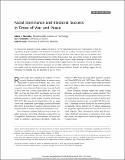Facial Dominance and Electoral Success in Times of War and Peace
Author(s)
Berinsky, Adam; Chatfield, Sara; Lenz, Gabriel
DownloadPublished version (501.4Kb)
Publisher Policy
Publisher Policy
Article is made available in accordance with the publisher's policy and may be subject to US copyright law. Please refer to the publisher's site for terms of use.
Terms of use
Metadata
Show full item recordAbstract
Do voters prefer dominant looking candidates in times of war? By replicating previous survey experiments, we find that respondents do prefer candidates with dominant facial features when war is salient. We then investigate whether these survey results generalize to the real world. Examining US Senate elections from 1990 to 2006, we test whether voters prefer candidates with dominant facial features in wartime elections more than in peacetime elections. In contrast with the survey studies, we find that dominant-looking candidates appear to gain a slight advantage in all elections but have no special advantage in wartime contexts. We discuss possible explanations for the discrepancy between the findings and conduct additional experiments to investigate one possible explanation: additional information about candidates may rapidly erode the wartime preference for dominant looking candidates. Overall, our findings suggest that the dominance-war findings may not generalize to the real world.
Date issued
2019-07Department
Massachusetts Institute of Technology. Department of Political ScienceJournal
Journal of Politics
Publisher
University of Chicago Press
Citation
Berinsky, Adam J. et al. "Facial Dominance and Electoral Success in Times of War and Peace." Journal of Politics 81, 3 (July 2019): dx.doi.org/10.1086/703384 © 2019 Southern Political Science Association
Version: Final published version
ISSN
0022-3816
1468-2508